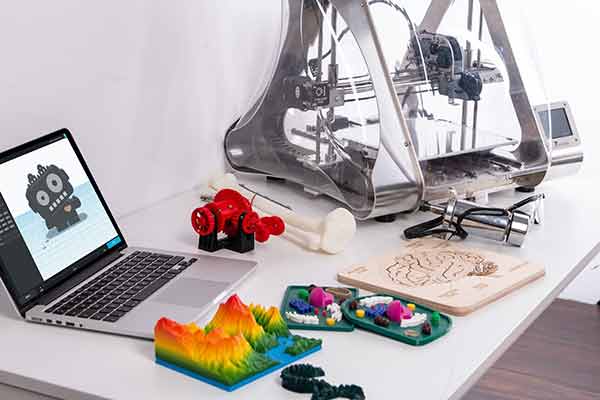A deep dive into 3D printing and additive manufacturing.
3D printing has come a long way since its advent with slow print times and frequent flow errors. Most would now agree that it has established itself as a viable alternative to traditional manufacturing processes in a range of high-performance industries, from aerospace to medical. The question that remains to be answered is: ‘Does 3D printing have a future?’
Here are 6 reasons why it absolutely does.
Rapid advances in medical technology like proton-based cancer therapy have brought in sweeping changes in healthcare, making possible what was previously thought to be fiction. Unfortunately, these technological advances have not coincided with a commensurate decrease in healthcare costs. In fact, with insurance density decreasing across the globe, costs are only inching upwards.
The silver lining here comes in the form of 3D printing being a part of those medical advances. Printers are now far smaller and can print more using less material, making them ideal candidates for manufacturing medical equipment in remote areas. This is particularly useful in places where access to humanitarian resources might be limited, and enables authorities to print crucial medical supplies like crutches or tools.
Additive manufacturing is no longer the sole property of companies with large R&D budgets. Evolutions in 3D printers and filaments have already made it a far more affordable manufacturing option compared to a decade ago, and looking forward, it’s only going to get better.
A large part of this is due to the fact that we now have access to cheaper and quicker printing techniques like Fused Deposition Modeling (FDM). Costs of 3D printing can vary drastically from one type to another. Direct Metal Laser Sintering (DMLS), used for working with metal powders, will be far costlier than something like FDM, which is typically used for cheaper plastics.
Similarly, filaments are also becoming cheaper due to an expansion in supply.
The availability of these cheaper printing filaments are complemented by the uptick in environmentally-friendly 3D printing materials. Research with degradable soy-based filaments is particularly interesting in this regard.
The sustainability of 3D printing is going to be an increasingly important aspect heading into the 2030s, especially with tightening global environmental regulation. The most recent indicator of these shifting priorities is the Glasgow Climate Pact. Companies that are looking to switch to 3D printing can scarcely afford to ignore the potential it has as an alternative to traditional high-emission manufacturing.

From manufacturing motion controllers to critical automotive parts, 3D printing shows an exciting versatility in light of the ever-increasing number of industries where it can be applied. This is the result of the range of price points available to manufacturers as well as the flexibility that 3D printing offers businesses.
For example, a start-up that wants to create a prototype for a cutting-edge product might not want to rely entirely on traditional manufacturing methods. Prototypes can be incredibly complex, with multiple moving parts that each require the utmost precision during production. 3D printing is filling that niche by giving businesses the option to design and produce prototypes that fit their specs perfectly, all in-house.
Printers aren’t just limited to using traditional materials like PLA filament or metal powders anymore. 3D printers can now use biological materials like living cells via “bioprinting” — that is, prints made up of layers of cells. This artificial tissue can be made to mimic our own organs and could revolutionize medical transplants.
These exciting new materials are being made available to more and more manufacturers through better supply lines and distributors. A major hindrance to 3D printing in the past used to be the bevy of middlemen one had to go through to access special materials like titanium metal powder. That’s set to change with the appearance of Amazon-like online marketplaces that are simplifying the ordering process.
One of the main reasons traditional assembly line manufacturing continues to dominate over 3D printing is the issue of speed. Speed is of the essence for businesses that have to push out products day in, day out—even, often, for smaller components like valves, which would other wise be prime candidates for additive manufacturing.
As the technology develops, we’re observing a significant decrease in printing times—even for the basic printers. In part, this is due to the production of higher quality materials, such as metal powders with increased flowability. In the future, this is going to be matched by improvements in printing methods that will eventually replace the slow layer-by-layer procedure that many printers still follow. This trend is already taking shape in the form of alternative printing methods like UV light printing.
With the increasing pace of advancements in the world of additive manufacturing, it’s clear to see that it will have a significant part to play in the years and decades to come. 3D printing will continue to be invaluable due to its adaptive nature, and businesses should aim to make the most of it when the time is right.
In this episode, I sat down with Beejan Giga, Director | Partner and Caleb Emerson, Senior Results Manager at Carpedia International. We discussed the insights behind their recent Industry Today article, “Thinking Three Moves Ahead” and together we explored how manufacturers can plan more strategically, align with their suppliers, and build the operational discipline needed to support intentional, sustainable growth. It was a conversation packed with practical perspectives on navigating a fast-changing industry landscape.